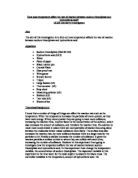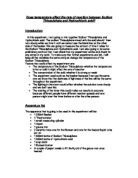INTRODUCTION:
I am going to be investigating how different variable will affect the rate of a reaction between Sodium Thiosulphate and Hydrochloric acid.
Sodium Thiosulphate + Hydrochloric acid Sodium Chloride + Sulphur dioxide + Sulphur + Water
Na2S2O3 + 2HCl 2NaCl + SO2 + S + H2O
Sodium Thiosulphate and Hydrochloric acid are both colourless solutions but when they are mixed together they become cloudy and eventually opaque.
We can obviously not measure rate directly, but what we can measure is the time taken for a change to occur.
Rate = Change/Time
I will take the time by placing the beaker containing the Thiosulphate on a piece of paper with a cross on it. I would start the timing as soon as I added the Hydrochloric acid to the solution and I would stop as soon as I could see the cross no longer.
For a reaction to take place two substances must collide. The rate of reaction depends on how many collisions occur in a given space for a given length of time. I will be measuring collisions/cm3/second.
However not all collisions lead to a reaction because in order to react existing bonds must be broken - this needs energy, in a collision the kinetic energy of colliding particles might not be enough to break bonds. The particles need what is called activation energy.
A successful collision is a collision when the particles colliding have activation energy and the bonds which are already there are broken and new bonds are formed.
VARIABLES
TEMPERATURE:
The temperature of the liquids will affect the rate of reaction because the hotter the particles are the more energy they will have and therefore the more likely they are to have activation energy. This would then mean that the rate of reaction would be faster because more of the particles will be colliding successfully.
CONCENTRATION:
The concentration of one of the substances would make the rate of reaction either slower or faster depending on whether you increase or decrease the concentration. This is because the less concentrated the solution is the less particles there are floating around ready to collide with the other particles and therefore create a reaction
CATALYSTS:
A catalyst is something that speeds up a reaction but remains chemically unchanged at the end of it. It provides a pathway of lower activation energy therefore the rate of reaction would be faster. Unfortunately there is no known catalyst for this reaction.
PRESSURE:
As a substance has its pressure increased there is an increase in the number of particles of gas in each cm3 which therefore increases the number of collisions in each cm3. Unfortunately it is very hard to compress liquids and near impossible with the equipment I have available to me.
I am going to be investigating how different variable will affect the rate of a reaction between Sodium Thiosulphate and Hydrochloric acid.
Sodium Thiosulphate + Hydrochloric acid Sodium Chloride + Sulphur dioxide + Sulphur + Water
Na2S2O3 + 2HCl 2NaCl + SO2 + S + H2O
Sodium Thiosulphate and Hydrochloric acid are both colourless solutions but when they are mixed together they become cloudy and eventually opaque.
We can obviously not measure rate directly, but what we can measure is the time taken for a change to occur.
Rate = Change/Time
I will take the time by placing the beaker containing the Thiosulphate on a piece of paper with a cross on it. I would start the timing as soon as I added the Hydrochloric acid to the solution and I would stop as soon as I could see the cross no longer.
For a reaction to take place two substances must collide. The rate of reaction depends on how many collisions occur in a given space for a given length of time. I will be measuring collisions/cm3/second.
However not all collisions lead to a reaction because in order to react existing bonds must be broken - this needs energy, in a collision the kinetic energy of colliding particles might not be enough to break bonds. The particles need what is called activation energy.
A successful collision is a collision when the particles colliding have activation energy and the bonds which are already there are broken and new bonds are formed.
VARIABLES
TEMPERATURE:
The temperature of the liquids will affect the rate of reaction because the hotter the particles are the more energy they will have and therefore the more likely they are to have activation energy. This would then mean that the rate of reaction would be faster because more of the particles will be colliding successfully.
CONCENTRATION:
The concentration of one of the substances would make the rate of reaction either slower or faster depending on whether you increase or decrease the concentration. This is because the less concentrated the solution is the less particles there are floating around ready to collide with the other particles and therefore create a reaction
CATALYSTS:
A catalyst is something that speeds up a reaction but remains chemically unchanged at the end of it. It provides a pathway of lower activation energy therefore the rate of reaction would be faster. Unfortunately there is no known catalyst for this reaction.
PRESSURE:
As a substance has its pressure increased there is an increase in the number of particles of gas in each cm3 which therefore increases the number of collisions in each cm3. Unfortunately it is very hard to compress liquids and near impossible with the equipment I have available to me.







